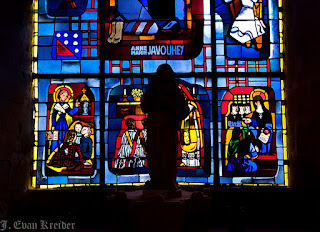The town of Blamont is in the département Doubs, in the Franche-Comté region near the border with Switzerland. Today's farming commune (including the town and its surrounding area) has about 1,100 residents.
The present Catholic church was dedicated in 1826. The bell tower has 3 bells ("Jeanne Rose" weighing in at 950 kg; "Pierre Marie", a mere 70 kg; and the 3rd is lovingly known as "Christian is my name, Catholic my surname"). The facade was refurbished in the 1990s.
One beautiful window commemorates poor St Joseph Marchand, a lad from Passavant who became a Catholic missionary to Vietnam. Even though he was a missionary, he joined an armed rebellion against the Emperor, somehow hoping to place the Emperor's Catholic relative on the throne. They controlled Saigon for several years before the rebellion was finally quelled. Marchand and friends were punished most horribly. Hot iron tongs were used to pull off his flesh, after which his body were hacked into bits and tossed into the ocean. In 1988, Pope John Paul II canonized Marchand along with other Vietnamese martyrs including French and Spanish missionaries to Vietnam, 37 Vietnamese priests and 59 Catholic laity. Marchand's feast day is November 30th.
We wisely decided to have lunch at Au Relais des Saveurs. The cuisine is very traditional in the local French-Swiss style.
Since the Richards (my wife's ancestors ) used to live near Blamont, we visited the local Catholic cemetery, but Mennonites would not be buried there.
An interesting statue honours a local citizen and politician, Jules Viette (1843-1894). Carvings (on the back, not shown here) depict a montbéliard (a special breed of cow bred by the Grabers, Swiss Anabaptist immigrants in the 1600s, possibly with help from the Lugbills). The cow recalling Viette's service as Minister of Agriculture (1887-1888). There is also a depiction of a locomotive which refers to Viett's brief time as Minister of Public Works, 1892-1893). A sword and pistol recall his feats during the War of 1870. Viette's bust towers over figures depicting a miner with his lantern (industry) and a barefoot peasant holding her sickle while resting on sheaves of wheat (agriculture).
Tuesday, November 29, 2011
Sunday, November 27, 2011
Winter Berries in Vancouver in November
Tuesday, November 22, 2011
Cathédrale Notre-Dame de Senlis (Senlis Cathedral)
When is a cathedral not a cathedral? Although the Concordat of 1801 placed the former bishopric of Senlis under that of Beauvais, thereby technically ending its status as the seat of the Bishop of Senlis, the Notre Dame Cathedral of Senlis enjoyed a long and distinguished history for many centuries and still fondly bears the honorific appellation of 'cathedral'.
Senlis was the third city to have a church built in the new Gothic style (after the Abbey of St Denis just north of Paris, and the Cathedral of Noyon). The present structure was begun in 1153 and essentially enclosed by 1191. Louis VII was particularly generous, granting Senlis a municipal charter of rights and several grants toward the construction of the cathedral. A severe lightning strike forced the citizens of Senlis to make extensive repairs to the cathedral's vaulting, and as time passed, the authorities opted to devote considerable resources to updating the cathedral's architectural style. Consequently, one can see a wide variety of styles in this one building. During the Revolution, Senlis fell on hard times, but was not dismantled since it was used to store the statuary of other churches. It did suffer interior damage to its own stonework until the French government finally declared it to be a national monument. Today this magnificent church is an active place of worship, recalling the centuries when it was a cathedral, but the church now lack the customary choir stalls, etc., all of which had been removed earlier.
Senlis was the third city to have a church built in the new Gothic style (after the Abbey of St Denis just north of Paris, and the Cathedral of Noyon). The present structure was begun in 1153 and essentially enclosed by 1191. Louis VII was particularly generous, granting Senlis a municipal charter of rights and several grants toward the construction of the cathedral. A severe lightning strike forced the citizens of Senlis to make extensive repairs to the cathedral's vaulting, and as time passed, the authorities opted to devote considerable resources to updating the cathedral's architectural style. Consequently, one can see a wide variety of styles in this one building. During the Revolution, Senlis fell on hard times, but was not dismantled since it was used to store the statuary of other churches. It did suffer interior damage to its own stonework until the French government finally declared it to be a national monument. Today this magnificent church is an active place of worship, recalling the centuries when it was a cathedral, but the church now lack the customary choir stalls, etc., all of which had been removed earlier.
 |
| Prayer Room, often used |
Location:
Senlis, France
Subscribe to:
Comments (Atom)


























































